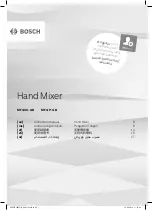
Section 4: Tutorial
Euphonix CS3000/2000 Operation Manual
4 - 55
dim functions operate from Monitor B’s
DIM
key. Monitor C’s Level control and
DIM
key are not operational in this mode.
This setup is perfect for 4-track monitoring during film mixing. With all three
monitors fed from one monitor level control you can address monitoring for 6-
track film formats. You can set different feeds to each monitor by selecting the
appropriate source in the
monitor SET
area for each output.
The Automute function and the Link function allow for a lot of different
monitoring combinations.
Normally the monitors work as three independent simultaneous outputs, each
sending its own source selection to its output via the level control. There is
only one set of EXT selectors so whatever combination of EXT A, B and C
inputs that has been selected will be picked up by each monitor when EXT is
selected as a source to the monitors.
It also makes it very easy for the engineer to send an external feed, say a
demo DAT, to the musician, simply by selecting an EXTernal input to feed the A
output. As these sources are additive, the DAT playback would be mixed with
the ST1 mix so the musician could play along with his demo.
These outputs can also be used as a simple 1:1 stereo line level submixer with
the capability of summing up to 6 separate stereo sources via the EXTernal
inputs down to one stereo output (Monitor Output) via a level control (which
gives unity gain when fully turned up). This is not the normal use for a monitor
selector but it is there if you need it.
If you select I/C in all three monitor menus you can select between three
different monitors in the control room, only one feed will be active at any one
time. You can also send the AFL/PFL signal to any combination of the three
monitors. (See Solo AFL and PFL earlier in this section)
For 4-track monitoring, set a pair of monitor outputs to be linked, say A and B
both linked to B. All you have to do is to set Monitor A to LINKB as mentioned
on the previous page. Different studios may use different monitor outputs for
the L-R and Center-Surround pair.
If you are mixing 4-track for film, ST1 bus can be used for the main left, right
pair and ST2 can be used for the center and mono surround speakers. Set
Monitor A to pick up ST1 and feed the left and right speakers from A Output.
Set Monitor B to pick up ST2 and feed the B left to the center speaker and the
B right feed to the mono surrounds. Now Monitor B level control will give you
4 channel level control.
The signal flow diagram on the next page shows the use of a Dolby 4-2-4
Surround Sound Encoder. What you hear on the monitors is the encoded, then
decoded 4-channel sound, as would be heard in a theater. The Dolby Matrix
includes switching to allow you to listen to the encoded stereo signal and the
discrete 4-channel signal prior to the decoder.
Monitor Combinations
and Examples
Film Monitor Mode
Summary of Contents for MixView CS2000
Page 1: ...CS3000 CS2000 Operation Manual Version 3 0 Revision 1...
Page 14: ...Table of Contents xiv Euphonix CS3000 2000 Operation Manual This page intentionally left blank...
Page 303: ...Euphonix CS3000 2000 Operation Manual A 1 A APPENDICES EUPHONIX MIXING SYSTEMS...
Page 304: ...A 2 Euphonix CS3000 2000 Operation Manual This page intentionally left blank...
Page 315: ...Index CS3000 2000 Operation Manual I 1 I INDEX EUPHONIX MIXING SYSTEMS...
Page 316: ...I 2 CS3000 2000 Operation Manual Index This page intentionally left blank...
Page 324: ...I 10 CS3000 2000 Operation Manual Index This page intentionally left blank...
















































